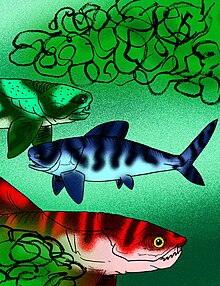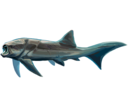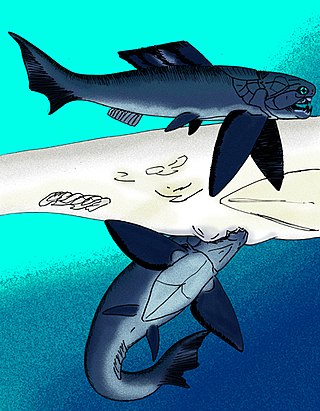
Dinichthys is an extinct monospecific genus of large marine arthrodire placoderm from the Late Devonian measuring around 3 metres (9.8 ft) long. Fossils were recovered from the Ohio Shale Formation along the Olentangy River in Delaware County, Ohio.
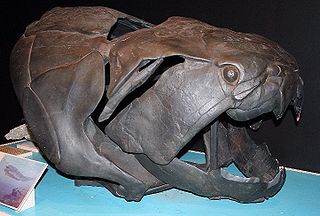
Dunkleosteidae is an extinct family of arthrodire placoderms that lived during the Devonian period. The gigantic apex predator Dunkleosteus terrelli is the best known member of this group.
Heintzichthys is an extinct monospecific genus of arthrodire placoderm that lived what is now Europe and North America during the Famennian stage of the Late Devonian period. The type specimen was discovered in the Cleveland Shale near Cleveland, Ohio, in the United States.

Gorgonichthys is extinct monospecific genus of large arthrodire placoderm. Fossils are found in the Upper Famennian Cleveland Shales of Late Devonian in Ohio. The type species is Gorgonichthys clarki.

Draconichthys elegans a selenosteid arthrodire placoderm from the Late Frasnian Kellwasserkalk facies of the Anti-Atlas Mountains of what is now Morocco. During the Late Devonian, the region would have been a shallow, algae-dimmed sea.
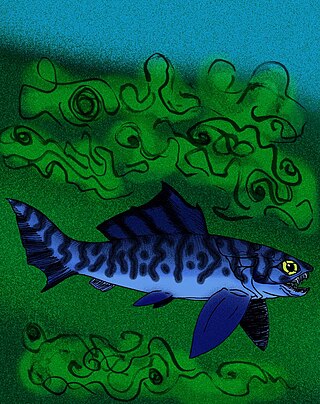
Hadrosteus is an extinct monospecific genus of large arthrodire placoderm from the Late Frasnian Kellwasserkalk facies of Bad Wildungen, Germany. It had large, double-pronged inferognathals, and serrated edges along its mandible, strongly suggesting that it was a fish-eating predator. The head had a triangular snout, and the trunkshield was short, but high, with a median dorsal plate that was broader than wide. The average skull length is about 16 centimeters.

Stenosteus is an extinct monospecific genus of medium-sized selenosteid arthrodire placoderms of the Late Devonian period known from the Upper Famennian Cleveland Shale of Ohio. Estimated skull lengths range from 6 to 9 centimeters Most fossils of Stenosteus have been scraps of armor and portions of tooth-plates suggestive of Selenosteus. In 1996, enough material of a new species, S. angustopectus, was recovered to allow a reconstruction of armor that resembles that of Selenosteus.
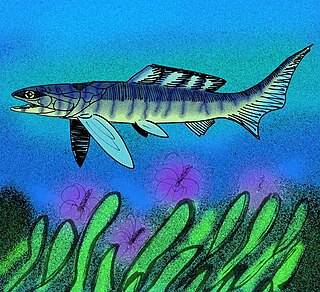
Gymnotrachelus is an extinct monospecific genus of large selenosteid arthrodire placoderm of the Late Devonian known from the Late Famennian Cleveland Shale of Ohio. The type species Gymnotrachelus hydei was originally reconstructed as physically resembling Selenosteus, with slightly smaller orbits. Later specimens led to a reappraisal, and now G. hydei is thought to have a more gar-like or barracuda-like build.

Microsteus is an extinct genus of small selenosteid arthrodire placoderms known from the Upper Frasnian Kellwasserkalk facies of Late Devonian Germany.
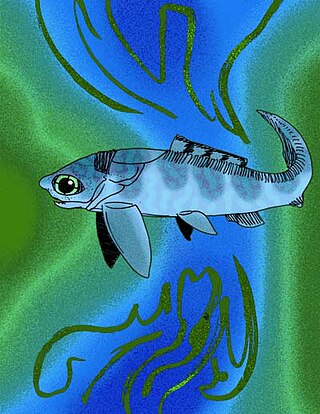
Enseosteus is an extinct genus of small selenosteid arthrodire placoderms known from the Upper Frasnian Kellwasserkalk facies of Late Devonian Germany and Morocco.
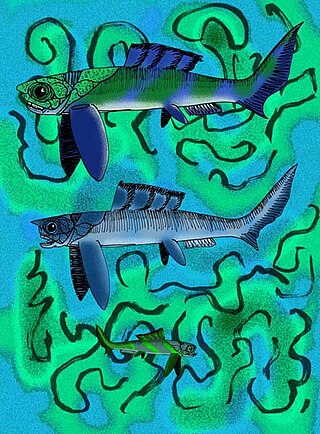
Rhinosteus is an extinct genus of small to medium selenosteid arthrodire placoderms of the Late Devonian known from the Upper Frasnian Kellwasserkalk facies of Bad Wildungen, Germany and Morocco.
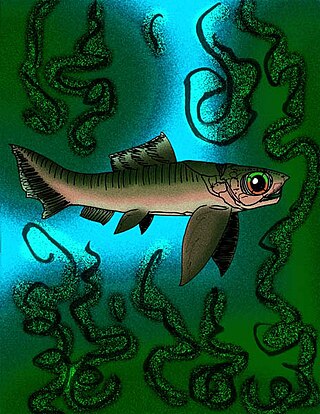
Braunosteus schmidti is a medium-sized selenosteid arthrodire placoderm known from the Upper Frasnian Kellwasserkalk facies of Late Devonian Bad Wildungen, Germany. B. schmidti has a broad skull about 9 centimeters long, and a short, but pointed rostrum. Its appearance is very similar to that of the basal selenosteid Pachyosteus.

Pachyosteus is an extinct monospecific genus of medium-sized selenosteid arthrodire placoderm known from the Upper Frasnian Kellwasserkalk facies of Late Devonian Bad Wildungen, Germany and from the Famennian portions of the Holy Cross Mountains of Poland. The type species Pachyosteus bulla has a broad skull about 7 to 10 centimetres long, a comparatively long median dorsal plate, and a short rostral plate that meets the pineal plate.

Coccosteidae is a family of arthrodire placoderms from the Early to Late Devonian. Fossils appear in various strata in Europe, North America and China.
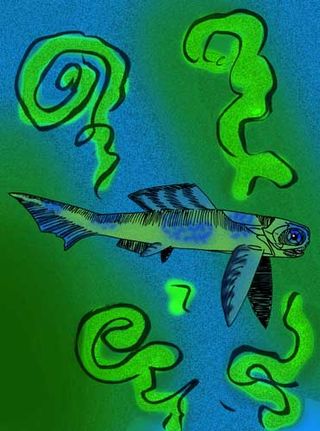
Walterosteus is an extinct genus of small selenosteid arthrodire placoderms known from the Upper Frasnian Kellwasserkalk facies of Late Devonian Germany and Morocco.

Dunkleosteoidea is an extinct superfamily of arthrodire placoderms that lived during the Devonian period. The gigantic apex predator Dunkleosteus terrelli is the best known member of this group.

Eubrachythoraci is an extinct clade of arthrodire placoderms within the suborder Brachythoraci, armored fish most diverse during the Devonian. Most are considered to be pelagic long-distance swimmers, leading to their widespread distribution beginning from at least the Middle Devonian period.

Pachyosteomorphi is an extinct clade of arthrodire placoderms within the Eubrachythoraci, armored fish most diverse during the Devonian. Most are considered to be pelagic long-distance swimmers, leading to their widespread distribution beginning from at least the Middle Devonian period.
Compagopiscis is an extinct genus of placoderm known from the Gogo Formation. It lived in the Upper Devonian of Western Australia. The genus is monotypic, with its only species being Compagopiscis croucheri.
Brachyosteus is an extinct genus of arthrodire placoderm from the Late Frasnian stage of the Late Devonian period. Fossils are found from Bad Wildungen, Germany.
